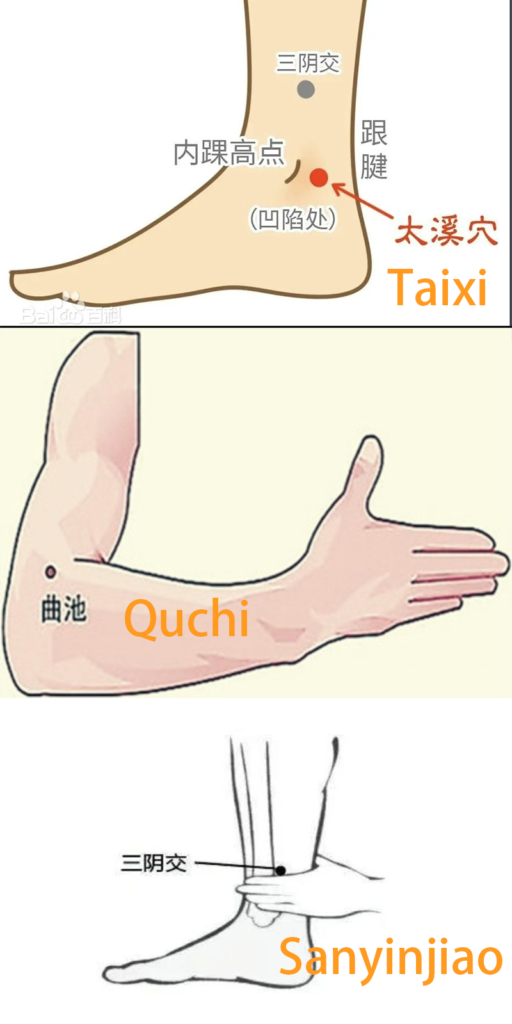Diabetes, known as “Xiao Ke” (消渴) in Traditional Chinese Medicine (TCM), is characterized by chronic metabolic dysfunction rooted in imbalances of Yin, Yang, Qi, and Blood. Among the 360+ acupoints in the human body, Zusanli (足三里, ST36), a pivotal point on the Stomach Meridian and one of the revered “Tianshi Twelve Acupoints” from classical texts like 《扁鹊神应针灸玉龙经》 (Bian Que’s Divine Jade Dragon Classic), holds profound therapeutic potential for diabetes. This article explores its mechanisms through the lens of TCM theory, classical acupoint applications, and modern scientific insights.
1. TCM Pathophysiology of Diabetes (Xiao Ke)
In TCM, diabetes arises from Yin deficiency with internal heat, disrupting the Triple Burner (San Jiao) and impairing the Lung, Spleen-Stomach, and Kidney systems:
- Upper Burner (Lung): Yin deficiency → excessive thirst (polydipsia).
- Middle Burner (Spleen-Stomach): Stomach fire → excessive hunger (polyphagia).
- Lower Burner (Kidney): Kidney Yin/Yang imbalance → frequent urination (polyuria).
The Spleen-Stomach, as the “Root of Postnatal Qi,” governs digestion and nutrient distribution. Dysfunction leads to damp-heat accumulation and Qi stagnation, exacerbating insulin resistance and hyperglycemia.
2. Zusanli (ST36): The Multifaceted Acupoint
2.1 Classical Attributes
- Location: 3 cun below Dubi (ST35), one finger-breadth lateral to the tibia.
- Meridian: Stomach Meridian of Foot Yangming.
- Five-Element Theory: Earth (Stomach belongs to Earth), symbolizing nourishment and stability.
- Tianshi Twelve Acupoints Significance: Described as “regulating abdominal disorders, warming cold stagnation, resolving dampness, and strengthening the legs.”
2.2 Core Functions
- Tonifies Spleen-Stomach Qi: Enhances digestion and transforms food into Qi and Blood.
- Clears Damp-Heat: Drains excess heat from the Middle Burner.
- Regulates Qi and Blood: Balances ascending/descending Qi dynamics in the San Jiao.
- Strengthens Wei Qi (Immunity): Improves resistance to chronic diseases.
3. Mechanisms of Zusanli in Diabetes Management
3.1 Restoring Spleen-Stomach Harmony
- Pathology: Spleen Qi deficiency → poor nutrient absorption → undigested “turbid dampness” → insulin resistance.
- Action: Stimulating Zusanli strengthens Spleen Qi, optimizing glucose metabolism and reducing postprandial hyperglycemia. Modern studies note its ability to modulate gut microbiota and pancreatic β-cell function.
3.2 Clearing Stomach Fire, Nourishing Yin
- Pathology: Chronic Stomach fire (Middle Burner heat) → excessive hunger and thirst → Yin consumption.
- Action: Zusanli regulates Stomach Meridian Qi, redirecting fire downward to cool heat without depleting Yin. This aligns with TCM’s “Bitter and Cold” herb strategy (e.g., Coptis for lowering blood sugar).
3.3 Enhancing Kidney-Lung Communication
- Pathology: Yin deficiency in Lung/Kidney → disrupted fluid metabolism → polyuria.
- Action: Via the Stomach-Kidney Meridian network, Zusanli indirectly nourishes Kidney Yin by improving Qi flow to the Lower Burner. Studies suggest it may upregulate aquaporin-2 in renal tissues, reducing urination frequency.
3.4 Combating Diabetic Complications
- Neuropathy/Vascular Damage: Chronic hyperglycemia generates blood stasis and phlegm-turbidity.
- Action: Zusanli’s Qi-activating effect improves microcirculation, alleviating numbness and ulcers. Research highlights its role in reducing oxidative stress and inflammatory markers (e.g., TNF-α, IL-6).
4. Synergy with Other Tianshi Twelve Acupoints
The Tianshi Twelve Acupoints form a holistic network for systemic regulation. For diabetes, pairing Zusanli with:
- Taixi (KI3): Nourishes Kidney Yin.
- Quchi (LI11): Clears Lung heat.
- Sanyinjiao (SP6): Regulates Liver/Spleen/Kidney.
amplifies therapeutic outcomes by addressing Xiao Ke’s “root deficiency (Yin) and branch excess (heat/dampness).”

5. Modern Evidence Supporting Zusanli
- Insulin Sensitivity: Electroacupuncture at Zusanli increases GLUT4 expression in skeletal muscles.
- Pancreatic Function: Upregulates insulin receptor substrates (IRS-1/2) in diabetic models.
- Neuroendocrine Axis: Modulates hypothalamic-pituitary-adrenal (HPA) axis to reduce stress-induced hyperglycemia.
6. Practical Application
- Stimulation Method: Apply firm pressure or circular massage for 3–5 minutes daily (both sides). Use moxibustion for Qi-deficient individuals.
- Optimal Timing: Morning (7–9 AM, Stomach Meridian’s peak hour).
- Contraindications: Avoid during acute hypoglycemia or skin lesions.
Conclusion
Zusanli (ST36) exemplifies TCM’s holistic philosophy, targeting diabetes through multitiered mechanisms: harmonizing the Middle Burner, cooling pathogenic heat, and revitalizing Qi-Blood circulation. Its inclusion in the Tianshi Twelve Acupoints underscores its historical and clinical prominence. While modern science continues to unravel its biomolecular effects, Zusanli remains a cornerstone of integrative diabetes care—bridging ancient wisdom with evidence-based practice.
Note: Zusanli therapy should complement, not replace, conventional diabetes management (e.g., medications, diet). Consult a licensed TCM practitioner for personalized protocols.


